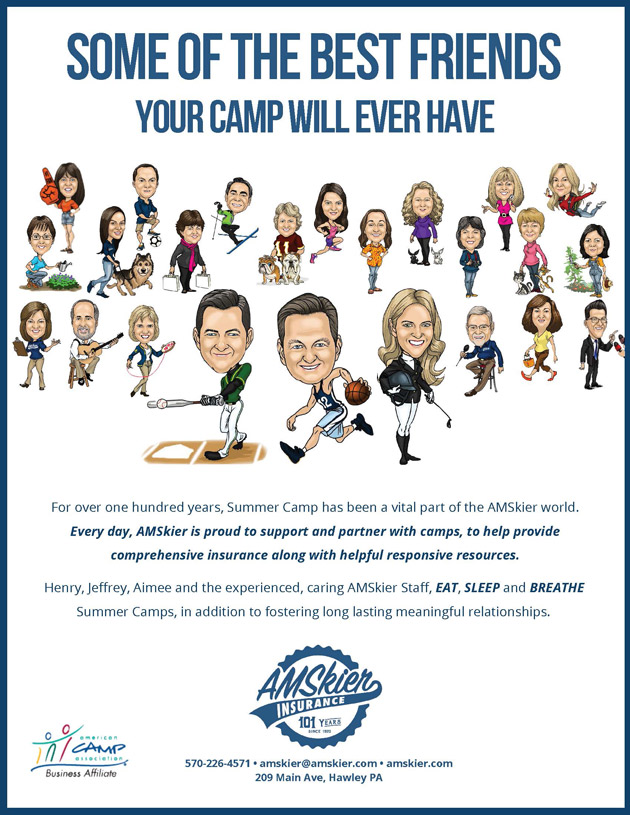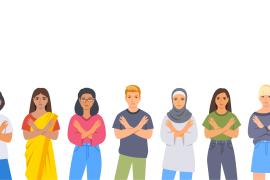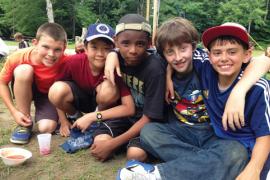The deaths of George Floyd, Breonna Taylor, Ahmaud Arbery, and too many others during 2020 is forcing the country to reconcile with the injustices that plague our systems. As camp professionals, we need to give campers a safe place to talk about how racism affects their lives.
A camp’s job is to teach and to help young people make sense of the world around them. Counselors and camp professionals must enable campers to become critical thinkers and leaders who can understand different perspectives with empathy. This is more important than ever, which makes talking about race with children an essential component of summer and year-round camp programming.
The American Camp Association (ACA), in partnership with Teaching Matters, offered a series of webinars over the past year enabling camp educators to discuss how to talk about anti-racism in the camp setting.
Those conversations are continued here.
A note about co-facilitation and co-authorship. Talking about race and racism in this country is complex and nuanced. In recognition of this challenge, having a “co” can be a useful tool when interacting with a mixed audience. Accountability is stronger and authenticity is more likely. Affinity groups, which we will talk about, are also great learning spaces for same “race” folks to meet and support one another’s conversations about race.
Who We Are and Why We Care
Chanika: I am an unapologetic, unabashed, proud Black woman navigating life in America, which is a mouthful in and of itself. When I tell people my family is from Selma, Alabama, and I spent many days and countless summers visiting my grandparents in good ole Dallas County, their eyes briefly enlarge and they give me a slow nod of surprise tinged with sadness. Americans, especially Black Americans, know the weight of Selma and the real estate it takes up in our collective consciousness.
When I think of my childhood, though, the first image that comes to mind is love — and it’s always intertwined with race. I’m old and experienced enough now to appreciate the significance of feeling this level of Black joy in the same city where my father wasn’t allowed to try on hats in department stores because he would “contaminate” the merchandise.
I’m a part of conversations about race because I was born into them when I entered the world with Black skin. I care about this work because color-blindness is an insidious ideology that posits seeing race as divisive and counterproductive to establishing unity. Yes, race is a manufactured social construct, but it has had and continues to have (in)tangible effects on how we all engage in and experience the world.
Lance: Like many white men, race has not always been a prominent part of my life; however, I am not immune from being socialized to have mainstream understandings of race from an early age. I continue to live and learn as my white body shows up in a world where a guy wearing white skin affords status that often goes unnoticed by the people who enjoy these benefits: the privilege of living in a costume without being noticed.
Let me be clear: because white people started the systems of injustice and racism in this country, white people have a responsibility to stop it. White people cannot wait around for the oppressed people within a society to fix that society. By extension, white educators — including camp educators — must attend to deconstructing systemic racism. We can do this by confronting the ways that white supremacy is centered in camp programs, traditions, and cultures. For many white people, confronting racism in this way can initially cause defensiveness, guilt, shame, or denial. I know, I’ve been there. While these are all completely natural feelings, they are also excuses for inaction and, therefore, not the intended result. Developing a healthy and positive white identity is a complex journey, and progress toward equality is no reason to slow down when the work is far from finished.
Tackling the Questions
The ACA webinars were attended by camp professionals committed to creating an environment conducive to meaningful and productive conversations about race. Participants were invited to raise questions, react, and share resources. The following “questions” are composites based on the original webinar chat logs. Our hope is that you see yourself and your work in camps captured in the thinking of your colleagues in the camp community.
I am white and afraid that I won’t say the right thing. I don’t want to offend or make it worse. How do I get it right?
Lance: A focus on “getting it right” and being perceived as “doing the right thing” are behaviors often associated with white supremacy culture. Culture is powerful precisely because it is so present and at the same time so very difficult to name or identify. Yet because we all live in a culture of white supremacy, these characteristics show up in the attitudes and behaviors of all of us — people of color (POC) and white people (Okun, n.d.). As we begin, and continue to dismantle white supremacy, it’s going to get messy because race is complex. Not having all the answers is OK, which can be especially challenging for white folks, because another aspect of white supremacy culture is perfectionism (Okun, n.d.).
As white people, we have to be open to making mistakes and remain open to feedback when we “say the wrong thing.” Ijeoma Oluo (2019) writes that “these conversations will not be easy, but they will get easier over time,” noting that “we have to commit to the process if we want to address race, racism, and racial oppression in our society.” In some cases, this process “may bring you face-to-face with issues of race and privilege that will make you uncomfortable.” I’m disquieted daily by my learning and unlearning about race, and remain committed to leaning in to this discomfort with curiosity.
At the same time, no one can tell us exactly what to say. We must find our own voices. Developing a positive and healthy white identity takes work and includes assuming responsibility for one’s own identity journey, being aware of whiteness and white identity, and continuing to learn about white supremacy. What we can’t afford to do is use fear as an excuse to avoid the conversation. The most important thing is that we say something. As Chanika often reminds me, “silence is violence” when it comes to white people waiting around on everyone else to speak up and act.
Chanika: This might be overkill in my limited wardrobe, but I have multiple T-shirts that bear the quote, “Faith over fear.” They always remind me to avoid the paralyzing and stifling nature of fear. Whether you’re religious or not, the message has power and could help as a starting point if you’re white and fearful of having conversations about race and racism. I’d encourage you to have faith that your intentions in addressing race stem from the desire to embrace color consciousness and, ultimately, anti-racism for yourself and your broader community. As Lance alluded to in his response, intentions alone aren’t enough. You have to be committed to the process and do the work to better understand whiteness while also being open to learning about other races and centering their experience.
I’d also offer up the reality that fear of conversations about race implies a negative association that should be unpacked. It’s normal, but why do we believe these conversations must be inherently contentious? They might make some folks uncomfortable, but discomfort and contention do not have to be synonyms. Talking about race is also not synonymous with talking about racism. Both conversations are necessary, but it is impossible to talk openly, critically, and honestly about race or the effects of racism if fear of “getting it right” is literally silencing the conversation.
Recommendations:
- Ijeoma Oluo (2019), So You Want to Talk about Race?
- Sandra M. Lawrence and Beverly Daniel Tatum (2004), “White Educators as Allies: Moving from Awareness to Action,” in Off/White: Readings on Race, Power, and Society
- Brita Belli (2020), “It’s never too early to talk with children about race” in Yale News: news.yale.edu/2020/06/15/its-never-too-early-talk-children-about-race
- Tema Okun, “White Supremacy Culture”: dismantlingracism.org/uploads/4/3/5/7/43579015/okun_-_white_sup_culture.pdf
We are a predominantly white camp. We have very few staff members of color, and we lack diversity in our camper and volunteer populations. How do we handle white staff who get defensive about “being attacked for being white” or ask, “Why does everything have to be about race?” Racism isn’t a problem here.
Lance: White people are often less aware of the racism we are swimming in, and therefore we are the ones who need to talk about race and racism the most. As psychologist Janet Helms says, “Only white people can end racism” (O’Hara, 2020). Helms notes, “Race is a power system,” a means of classifying people and “determining who has the power, and who doesn’t.” For camps that are entirely white, affinity spaces can be helpful vehicles for white folks to speed up their journey toward being anti-racist — not places to feel guilt, shame, or denial, which are all off-ramps to taking responsible action. Have a look at White Awake, an organization whose website combats white supremacy by focusing on educational resources designed to support the engagement of people who’ve been socially categorized as “white” in the creation of a just and sustainable society. Affinity groups are not just for white folks. At Teaching Matters, all of my colleagues of various backgrounds have the opportunity to opt in to a racial affinity group with other coworkers sharing a common race who gather with the intention of finding connection, support, and inspiration.
Chanika: I respect the question, but I’m always fascinated by the claim that racism doesn’t exist “here.” Racism is real and exists in this country. Race and racism affect us all, and while it’s not isolated to people who have been minoritized, the most systemically negative effects have been felt by Black and brown individuals. The color of someone’s skin confers different levels of privilege, opportunities, and access that cannot be denied — even if we find that truth repulsive, dehumanizing, and just plain ugly. Check out works by Ava DuVernay, Ibram Kendi, James Baldwin, and Tim Wise if you need more context and content. Embracing conversations about race, racism, color consciousness, and/or anti-racism should not be seen as an attack or an attempt to “other” or guilt anyone. Instead, they are opportunities for inclusivity — forums that show genuine appreciation for races and cultures that have been marginalized — and they reflect camp personnel’s commitment to living out the very reason for camp’s existence.
We only have to look at ACA’s mission for confirmation that these conversations are essential regardless of a camp’s demographics. How do we avoid these conversations or feel like they’re problematic if a major contention of the ACA is that “children and adults have the opportunity to learn powerful lessons in community, character-building, skill development, and healthy living — lessons that can be learned nowhere else”? What community are we looking to build if we can’t talk about race and the effects it has on us all, the historic and systemic nature of racism, or the ways we have internalized lessons about ourselves and others that may affect our well-being and the way we engage in the world? ACA’s vision is to enrich lives and change the world, and many of us espouse this same belief and ultimate goal for the people we’re lucky enough to serve at camp and in our broader communities. This won’t happen if silence, defensiveness, or denial wins out.
The National Museum of African American History and Culture offers these three reasons for having conversations about race:
- Everyone has a racialized identity.
- Racialized identity has a major impact on a person’s life.
- Race is a defining social construct in American life.
The museum itself is on the must-see list, but I’d also recommend its website for its repository of enlightening resources that could inform conversations about race. The resources have been separated into eight categories that I believe lend themselves well to this overall topic, especially for leaders looking to infuse appreciation for racial identity and open dialogue into their camps.
Recommendations:
- Janet Helms (2019), A Race Is a Nice Thing to Have: A Guide to Being a White Person or Understanding the White Persons in Your Life
- White Awake homepage. whiteawake.org
- National Museum of African American History and Culture’s Talking about Race: nmaahc.si.edu/learn/talking-about-race
We have heard from staff of color that they do not want to talk about race with campers. Camp is their safe place where they feel accepted and do not want to be singled out for their differences. How do we balance the learning of white and POC campers without repeating implicit bias and unintentionally hurting someone? We want to avoid tokenizing staff or campers of color to teach white people.
Chanika: My body and spirit fully understand why staff of color might not want to talk about race at camp: it’s exhausting, can feel counterproductive, and can inadvertently contribute to the narrative that we’re a monolith. It’s easier for one person’s truth and experience to tragically become the gospel for all Black and brown people, especially given the likelihood that the white people they’re talking to have limited experience with many people of color. We’re acutely aware that the Western ideal of individualism often skips communities of color. We tend to carry the weight of representing our race in spaces where we are the numerical minority.
Speaking from my own truth and position, I find that people of color do want to talk about race. They just don’t want to talk about it with you, particularly if the you is a collective body that only wants to check a box to say they’ve had the conversation for performative purposes, without making any substantive changes or improvements.
Or the you who tries to “race-splain” whenever a person of color shares their experience, thereby diminishing or reframing their perspective to something more palatable and less likely to center racial identity.
Or the you who is relying solely on us for education on race, racism, color consciousness, or anti-racism. We can — and should be — a part of your educational journey, but you should not be looking for people of color to chauffeur you around like the 21st-century version of Driving Miss Daisy. It’s insulting and reminds me that when Driving Miss Daisy won the Oscar for Best Picture back in 1990, Spike Lee’s Do the Right Thing wasn’t even nominated in that category. Do you see how a box is checked, but not one that really reflects a desire for change, growth, or a conversation that elevates the beauty of life for people of color while also acknowledging the injustices and hardships inflicted upon them?
If staff of color don’t want to talk with you about race, it might be safe to assume they don’t want you to talk to campers of color about race either. They’ll just remain silent about it as well. I offer this as an opportunity for self-reflection, not an indictment or point of paralysis.
Yes, your staff of color may be tired and uninterested in possibly retraumatizing themselves or their campers by participating in conversations about race. No one should ever be forced to participate if they are not emotionally, mentally, or spiritually in a place to do so. Camp environments can have an anesthetic effect for many people of color who want to dull the negative aspects of their racialized identities, and it’s OK if they want to lean into that reality. Your willingness and desire to have open conversations about race and racism along with your commitment to changes or enhancements that show appreciation of the fullness of your camp community members’ identities should not waver, however, because the anesthesia will wear off.
- I encourage you to begin with clarity about your why. Why are conversations about race and racism important to you and your camp community? This work isn’t prescriptive, but I think The Opportunity Agenda’s “Ten Lessons for Talking About Race, Racism, and Racial Justice” can offer a helpful starting point if you’re struggling. While the article focuses on messaging, it offers an exercise that may get you closer to clarity — applying a “Values, Problem, Solution, Action” framework to establish a way to communicate:
- Values. Why should anyone care?
- Problem. Why is racism or silence around conversations of race a threat to those shared values?
- Solution. What needs to happen?
- Action. What concrete ask do you have for the community?
If it is clear that everyone bears responsibility for creating open dialogue about race and racism and that it is embedded in the fabric of the camp community, it becomes more difficult to tokenize people of color and more likely that they will want to participate in the conversation. If camp programs, policies, songs/chants, nomenclature, etc., have been examined through the lens of equity and the voices of those traditionally de-emphasized have been prioritized in any potential modifications, perhaps inclusivity can start to become normalized.
Lance: As white people, we should read, listen, and learn. Step back and step up at the same time. Pay attention to the space we take up in this discourse. Listen to and believe our friends and colleagues of color. Lean in to their stories. I offer up Katherine “Katburn” Hepburn’s (2020) reflections in an important blog Thoughts on Being Black at Camp:
It was something we never thought we’d see in our time at camp: Two dark-skin Black staff members, who went to camp together and understood how hard it can be to be Black at camp, leading the most diverse staff we’ve ever been on . . . . As Head Female, I saw firsthand how today’s Black campers STILL feel micro-aggressed, othered, and targeted at camp by white staff members and campers. Experiences that echoed my own and other Black staff members who went to camp.
Because most camps are predominantly white spaces, recognizing the reality of race requires intentionality; we can’t simply hope the issue doesn’t exist — or wish it away.
Ania Fiedler and Melissa Taylor (2021) rightly point out that “viewing camp as a space where camp magic overrides everything and is something that just happens naturally is a dangerous mindset.” We all know the benefits of camp, and our goal is to expand these benefits from a privileged few to all children. However, the safe place / magic mindset “implies that nothing can go wrong and that we don’t have to be intentional about creating that safe space.” Their thoughtful three-part blog series covers six steps, with ideas and tools to help initiate conversations with staff about race and privilege at summer camp and including involving your staff members in the process. Echoing Chanika, Fiedler and Taylor recommend having “intentional conversations with your Black, Indigenous, and other people of color (BIPOC) staff members. Do not assume that BIPOC staff want to be included in this work, and do not push them out of the process because of your own fears and insecurities. It is crucial to ask these staff members if and how they’d like to be involved and then respect their decisions” (2021).
Recommendations:
- Ania Fiedler and Melissa Taylor (2021), Race and Privilege at Summer Camp: Acknowledge That They Exist in Your Organization. Camp Minder. campminder.com/go/race-and-privilege-at-summer-camp-acknowledge-that-they-exist/
- Jasmine Roberts (2019), TEDxOhioStateUniversity, I’m tired of talking about race: ted.com/talks/jasmine_roberts_i_m_tired_of_talking_about_race/transcript?language=en
- The Opportunity Agenda’s (July 2020), Ten Lessons for Talking about Race, Racism, and Racial Justice: opportunityagenda.org/explore/resources-publications/lessons-talking-about-race-racism-and-racial-justice
- Sarah Kurtz McKinnon (2020), Black Lives Matter. The Summer Camp Society: thesummercampsociety.com/blog/2020/7/29/black-lives-matter
- Leilani Nussman (2020), Introduction to Anti-Racism in Summer Camps: gocamp.pro/blog/anti-racism-in-summer-camps
How do we talk about race while existing practices of our camp and industry have roots in racism? Our organization clearly benefits from that systemic racism, but we are committed to engaging in the process of reconciliation with local Indigenous peoples on whose land we travel.
Lance and Chanika: Our nation continues to face the residual implications of inequality, and camps have their own place in this history of injustice. We must first recognize that many camps contributed to or perpetuated prejudice in their early years, and the industry has a vital role to play in leveling the playing field today. Even now, many camp traditions imitate, appropriate, and misrepresent Indigenous ceremonies, names, and cultural practices of dress and craft. As Stephen Fine and Thomas (Tad) McIlwraith (2018) make clear, “contemporary camp programming should encourage an awareness of contemporary Indigenous peoples and their traditional homelands as opposed to simply projecting an historical or idealistic bias that may perpetuate the idea that ‘Indians’ exist only in the past.” As such, camps do not want to be sending out wrong messages, and instead should assist campers in learning about Native American history and cultures. Education World’s Lessons on Native Americans (2015) is an aid to developing classroom curriculum for non-Indigenous people. These activities, submitted by innovative educators from across the United States, are readily transferable to a camp setting and include role play and drama, word games and codes, preparing traditional foods, art projects, and more.
Amanda Shore’s (2015) work in this area captures our thinking best:
Camps that encourage imagination and make-believe ought to be valued as fertile environments, and existing programming can be used to re-imagine and re-mythologize identities. Outdoor classrooms ought to continue to pursue transformative experiential learning, maintaining the social structure while slowly introducing new songs, dances, activities, and stories. Rather than silencing all conversations about Indianness out of shame and discomfort, camps ought to allow Indigeneity to be re-imagined through partnerships with Indigenous educators, and by declaring the cultural, spiritual, and territorial sovereignty of Indigenous peoples.
History is both a reminder of how much camps have achieved and a motivator for overcoming our lingering limitations. Can camps serve as a landscape for learning hard history, forging a way by envisioning a just and equitable future for us all? We must provide pathways for all young people to benefit from the summer camp experience, especially those children most underserved and marginalized by school systems and society.
Recommendations:
- JUUStice Washington’s (n.d.) Truth and Reconciliation website: juustwa.org/program-areas/issues/first-american-indian-nations/our-work/truth-and-reconciliation/
- Stephen Fine and Thomas (Tad) McIlwraith (2018), “Indigenous Instructional Programming for Camp Professionals,” Camping Magazine: ACAcamps.org/resource-library/camping-magazine/indigenous-instructional-programming-camp-professionals
- Education World (2015), “Celebrate Native Americans in the Classroom”: educationworld.com/a_special/native_americans.shtml
- Amanda Shore (2015), Notes on Camp: A Decolonizing Strategy: ccamping.org/wp-content/uploads/2015/05/A.Shore-Notes-On-Camp.pdf
Where Do We Go from Here?
Summer camp settings offer a unique experience and opportunity for young people to explore, discover, and experiment — a space where it is possible for new meanings and understanding to emerge. Children desperately need time with other children and adults to negotiate contradictions and complexities, consider alternatives, identify the compelling. Talking about race, however, has largely been absent from camp curricula despite these conversations having educational value.
By ignoring race, we mean to send the message that race shouldn’t matter. But the message others receive is often that race doesn’t matter. Some will say that merely mentioning race or disclosing the ugly history of racism is divisive. Intellectually, well-meaning people can come down on either side of this debate. In affirmative action cases before the Supreme Court involving the constitutionality of lower school programs in Seattle, Washington, and Louisville, Kentucky, Chief Justice John Roberts wrote, “The way to stop discrimination on the basis of race is to stop discriminating on the basis of race” (Turner, 2015).
Justice Sonia Sotomayor, on the other hand, responded: “The way to stop discrimination on the basis of race is to speak openly and candidly on the subject of race . . . with eyes open to the unfortunate effects of centuries of racial discrimination.”
Ultimately, it comes down to what we value. Paraphrasing Justice Ruth Bader Ginsburg on the matter, our belief is that there are practical differences between the use of race to keep the races apart and the use of race to bring the races together.
Camps can’t afford to join the long list of those who believe they can accomplish their mission and vision while remaining color-blind. Doing so fosters false harmony and superficial connections that are too fragile to be long-lasting. Perhaps Michelle Alexander’s assertion in The New Jim Crow (2012) is a more eloquent expression of this belief: “The color blindness ideal is premised on the notion that we, as a society, can never be trusted to see race and treat each other fairly or with genuine compassion. A commitment to color consciousness, by contrast, places faith in our capacity as humans to show care and concern for others, even as we are fully cognizant of race and possible racial differences.”
Aspiring to have color consciousness is just one of the ways we create places and spaces that fully validate and affirm everyone’s identity. We must continue to seek avenues to embrace the full humanity of all people in camps. It is in seeing ourselves and others for who we truly are that we eventually become us. Summer camps don’t get a pass.
We leave you with Hepburn’s (2020) passionate plea: “I hope summer camps across the country start analyzing their programs through a social justice lens, because although summer camp feels like an escape from the ‘real world,’ real-world problems like racism, sexism, and homophobia exist within the camps we know and love.”
Photo courtesy of YMCA Camp Woodstock, Woodstock Valley, CT.
Chanika R. Perry, EdD, is the director of education programs at Hands On Atlanta and a school board member at an elementary school designed to bring together refugee, immigrant, and local children. Prior to these roles, she was a HS principal in Atlanta. She has been involved in the fields of youth development and education for 21 years, mostly in New York City and Atlanta.
Lance Ozier, EdD, is a senior education consultant at Teaching Matters and has been on the faculty of The City University of New York since 2009. Born and raised on a Georgia farm, he now lives in New York, and has previously taught and worked in Atlanta and New York City classrooms. Lance also spent 15 seasons in the Catskill Mountains at Morry’s Camp.
Chanika and Lance have been friends for over 20 years and worked together at Project Morry for over a decade.
References
Alexander, M. (2012). The new Jim Crow: Mass incarceration in the age of colorblindness. The New Press.
Belli, B. (2020, June 15). It’s never too early to talk with children about race. Yale News. news.yale.edu/2020/06/15/its-never-too-early-talk-children-about-race
Education World (2015). Celebrate Native Americans in the Classroom. educationworld.com/a_special/native_americans.shtml
Fiedler, A., & Taylor, M. (2021, March 2). Race and privilege at summer camp: Acknowledge that they exist in your organization. Camp Minder. campminder.com/go/race-and-privilege-at-summer-camp-acknowledge-that-they-exist/
Fine, S., & McIlwraith, T. (2018). Indigenous instructional programming for camp professionals. American Camp Association. ACAcamps.org/resource-library/camping-magazine/indigenous-instructional-programming-camp-professionals
Helms, J. (2019). A race is a nice thing to have: A guide to being a White person or understanding the White persons in your life (3rd ed.). Cognella Academic Publishing.
Hepburn, K. (2020, July 30). Thoughts on being Black at camp. The Summer Camp Society. thesummercampsociety.com/blog/2020/7/30/thoughts-on-being-black-at-camp
JUUstice Washington. (n.d.). Truth and Reconciliation. juustwa.org/program-areas/issues/first-american-indian-nations/our-work/truth-and-reconciliation/
Lawrence, S. M. & Tatum, B. D. (2004). White educators as allies: Moving from awareness to action (revised). In M. Fine, L. Weiss, L. Powell, L. Pruitt and A. Burns (Eds.). Off/White: Readings on power, privilege and resistance, 2nd edition, (pp.362-372). Routledge.
McKinnon, S.K. (2020, July 29). Black Lives Matter. The Summer Camp Society. thesummercampsociety.com/blog/2020/7/29/black-lives-matter
National Museum of African American History and Culture. (n.d.). Talking about race. Smithsonian Institute. nmaahc.si.edu/learn/talking-about-race
Nussman, L. (2020, August 10). Introduction to anti-racism in summer camps. Go Camp Pro. gocamp.pro/blog/anti-racism-in-summer-camps
O’Hara, D. (2020, October 26). Janet Helms studies the mechanisms of inequality. American Psychological Association. apa.org/members/content/race-mechanisms-inequality
Okun, T. (n.d.) White Supremacy Culture. Dismantling Racism. dismantlingracism.org/uploads/4/3/5/7/43579015/okun_-_white_sup_culture.pdf
Oluo, I. (2019). So you want to talk about race. Hachette.
Roberts, J. (2019). I’m tired of talking about race. TED. ted.com/talks/jasmine_roberts_i_m_tired_of_talking_about_race
Shore, A. (2015). Notes on camp: A decolonizing strategy. Canadian Camping Association. ccamping.org/wp-content/uploads/2015/05/A.Shore-Notes-On-Camp.pdf
The Opportunity Agenda (2020, July). Ten lessons for talking about race, racism, and racial justice. https://www.opportunityagenda.org/explore/resources-publications/lesson…
Turner, R. (2015, January). The way to stop discrimination on the basis of race… Stanford Journal of Civil Rights & Civil Liberties, XI, 45-86. corteidh.or.cr/tablas/r33547.pdf
White Awake. (n.d.). Homepage. whiteawake.org






